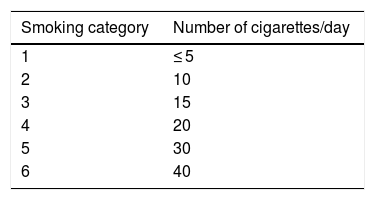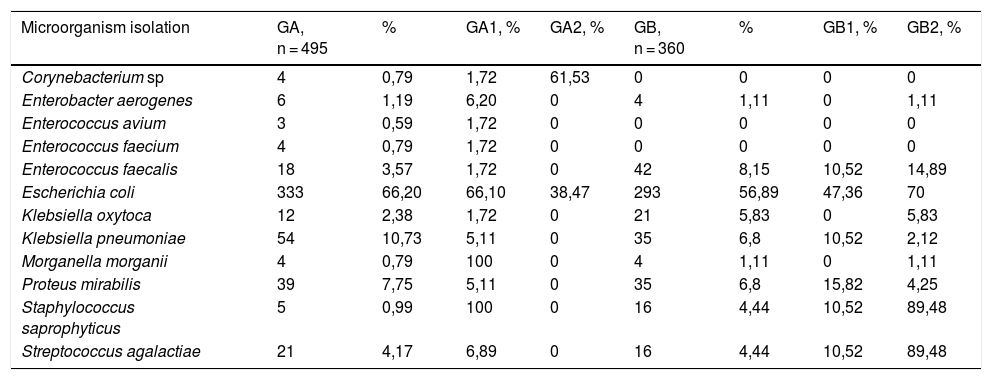The influence of tobacco on the microbiological spectrum, resistance-sensitivity pattern and evolution in patients with recurrent urinary tract infections (RUTI) is analyzed. Evaluation of the effect of polyvalent bacterial vaccine on the prevention of RUTI and smoking status.
Material and methodsRetrospective multicenter study of 855 women with RUTI receiving suppressive antibiotic treatment or bacterial vaccine between 2009 and 2013. Group A (GA): Antibiotic (n = 495). Subgroups: GA1 non-smoker (n = 417), GA2 smoker (n = 78). Group B (GB): Vaccine (n = 360). Subgroups: GB1 non-smoker (n = 263), GB2 smoker (n = 97). Variables: Age, pre-treatment UTI, disease-free time (DFT), microbial species, sensitivity and resistance. Follow-up at 3, 6 and 12 months with culture and SF-36 questionnaire.
ResultsMean age 56.51 years (18–75), similar between groups (p = 0.2257). No difference in the number of pretreatment UTIs (p = 0.1329) or in the distribution of the bacterial spectrum (p = 0.7471). DFT was higher in subgroups B compared with A. Urine cultures in GA1: E. coli 62.71% with 8.10% resistance (33% quinolones; 33% cotrimoxazole; 33% quinolones + cotrimoxazole); in GA2 E. coli 61.53% with 75% resistance (16.66% quinolones; 33.33% quinolones + cotrimoxazole; 16.66% amoxicillin-clavulanate; 16.66% erythromycin + phosphomycin + clindamycin) (p = 0, 0133). There were no differences between patients of GA treated with cotrimoxazole and nitrofurantoin (p = 0.8724). Urine cultures in GB1: E. coli 47.36% with 22.22% resistance (5.55% ciprofloxacin; 5.55% cotrimoxazole; 5.55% ciprofloxacin + cotrimoxazole; 5.55% amoxicillin / clavulanic acid). In GB2 E.coli 70.02% with 61.90% resistances (30.76% quinolones; 30.76% cotrimoxazole; 30.76% quinolones + cotrimoxazole; 17.69% amoxicillin-clavulanic acid) (p = 0,0144).
ConclusionsThe development of bacterial resistance is more frequent among women with smoking habits and recurrent urinary infections. This could influence a worse response to preventive treatments, either with antibiotics or vaccines.
Se analiza la influencia del tabaco en el espectro microbiológico, patrón de resistencia-sensibilidad y evolución en pacientes con infección de orina de repetición (ITUR). Evaluación del efecto de vacuna bacteriana polivalente en la prevención de las ITUR y el estado como fumador.
Material y métodosEstudio retrospectivo multicéntrico de 855 mujeres con ITUR tratadas con pauta antibiótica supresiva o vacuna bacteriana entre 2009 y 2013. Grupo A (GA): Antibiótico (n = 495). Subgrupos: GA1 no fumadora (n = 417), GA2 fumadora (n = 78).Grupo B (GB): Vacuna (n = 360). Subgrupos: GB1 no fumadora (n = 263), GB2 fumadora (n = 97).Variables: Edad, ITU pre-tratamiento, tiempo libre de enfermedad (TLE), especie microbiana, sensibilidad y resistencia. Seguimiento a 3, 6 y 12 meses con cultivo y cuestionario SF-36.
ResultadosEdad media 56,51años (18–75), similar entre grupos (p = 0,2257). Sin diferencia en número de ITU pre-tratamiento (p = 0,1329) ni en distribución del espectro bacteriano (p = 0,7471). TLE fue superior en los subgrupos B respecto a los correspondientes A.Urocultivos en GA1: E. coli 62,71% con 8,10% resistencia (33% quinolonas; 33% cotrimoxazol; 33% quinolonas+cotrimoxazol); en GA2 E. coli 61,53% con 75% resistencia (16,66% quinolonas; 33,33% quinolonas + cotrimoxazol; 16,66% amoxi-clavulánico; 16,66% eritromicina+fosfomicina+clindamicina) (p = 0,0133). En GA, no hubo diferencias entre pacientes tratadas con cotrimoxazol y nitrofurantoina (p = 0,8724).Urocultivos en GB1: E. coli 47,36% con 22,22% resistencias (5,55% ciprofloxacino; 5,55% cotrimoxazol; 5,55% ciprofloxacino+cotrimoxazol; 5,55% amoxicilina/clavulánico). En GB2 E.Coli 70,02% con 61,90% resistencias (30,76% quinolonas; 30,76% cotrimoxazol; 30,76% quinolonas+cotrimoxazol; 17,69% amoxi-clavulánico) (p = 0,0144).
ConclusionesEn mujeres con hábito tabáquico e infecciones urinarias de repetición es más frecuente la aparición bacterias resistentes, lo cual podría influir en una peor respuesta a los tratamientos preventivos, ya sea antibióticos o vacuna.
Artículo
Comprando el artículo el PDF del mismo podrá ser descargado
Precio 19,34 €
Comprar ahora










